Ever find yourself in a rut with your noodle game? Ramen’s great, sure.
We all love it. Yet, sometimes, shaking things up is a must.
We’ve dug around and found some top-notch swaps for those classic strands.
These substitutes? Game-changers.
They’re more than just alternatives; they’re a fresh spin on your noodle fix.
From rice noodles to zoodles, we’re here to guide you.
Each option packs its unique punch, promising to keep your meals exciting.
Ready to transform your noodle dishes? Let’s jump right in.
What is Ramen Noodles?

Ramen is Japan’s big bowl of noodles.
A meal-in-one, it typically contains noodles, meat, and vegetable leaves.
All the elements of a full meal poured into a steaming bowl of comfort.
The noodles themselves are made from flour and water, of course, but the Japanese also add kansui.
Kansui is a type of alkaline water containing sodium carbonate.
This makes the noodle distinctive from other noodles but is also the source of the excess sodium.
The broth is traditionally made from stock based on chicken or pork.
This gives the soup a rich, hearty flavor that is rich in protein and other nutrients.
Leafy vegetables and boiled eggs are often added as toppings to ramen noodles.
5 Best Substitutes for Ramen Noodles
Ramen noodles are a popular staple in many Asian cuisines, known for their chewy texture and ability to absorb flavors.
However, if you’re looking for substitutes or want to try different noodle options, there are several alternatives that can provide a similar experience.
| Substitute | Key Characteristics | Proper Ratio |
|---|---|---|
| Udon | Thick and chewy wheat noodles | Use an equal amount of Udon noodles as a substitute for Ramen noodles |
| Soba | Thin and nutty buckwheat noodles | Use an equal amount of Soba noodles as a substitute for Ramen noodles |
| Rice Noodles | Thin and translucent noodles | Use an equal amount of Rice noodles as a substitute for Ramen noodles |
| Chinese Egg Noodles | Yellow and springy noodles | Use an equal amount of Chinese Egg noodles as a substitute for Ramen noodles |
| Green Bean Noodles | Light and delicate noodles made from mung beans | Use an equal amount of Green Bean noodles as a substitute for Ramen noodles |
Now let’s dive into each substitute in more detail:
1 – Udon
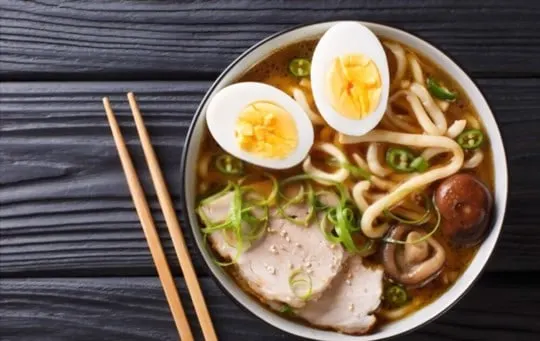
Udon is another kind of noodle originating from Japan, like ramen.
It is made from wheat flour, water and salt, and contains less sodium content than ramen.
The noodles are pretty thick and often flat, though you can find them rounded also.
Traditionally, udon is prepared with a soup much like ramen, and there are many different styles.
A common dish is Miso Nikomi Udon- udon noodles simmered in miso broth with chicken and vegetables.
A simple way to eat udon is in Kake Udon – a noodle soup made from dashi, soy sauce and mirin.
You can make udon noodles at home or get them store-bought to replace ramen in any recipe.
- Key Characteristics: Udon noodles are thick and chewy wheat noodles that have a mild flavor. They are commonly used in Japanese cuisine and are known for their satisfying texture. Udon noodles work well in soups, stir-fries, or even cold salads. Use an equal amount of Udon noodles as a substitute for Ramen noodles in your recipes.
2 – Soba
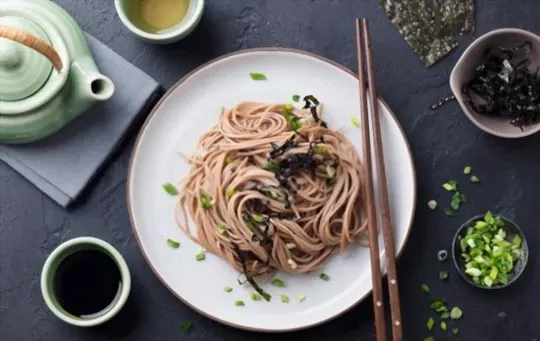
Authentic soba noodles are healthier than ramen, as they are made from buckwheat flour.
Soba noodles are brown and thin like spaghetti.
Because they are made from buckwheat, they are gluten-free and contain a lot of protein and fiber.
Soba noodles have a taste described as earthy, with a slight, nut-like flavor.
Also originating from Japan, these noodles are served everywhere, from fast food to expensive restaurants.
Soba can be easily swapped in for ramen in any recipe you make.
Soba is perfect if you are searching for a healthy alternative to ramen, so it is suitable for all diets unless you have buckwheat allergies.
Be sure to get authentic soba, though, as some brands will mix white flour into the product.
- Key Characteristics: Soba noodles are thin noodles made from buckwheat flour, which gives them a nutty flavor. They have a slightly chewy texture and can be enjoyed both hot or cold. Soba noodles are commonly used in Japanese dishes such as soups, stir-fries, or served with dipping sauces. Use an equal amount of Soba noodles as a substitute for Ramen noodles in your recipes.
3 – Rice Noodles
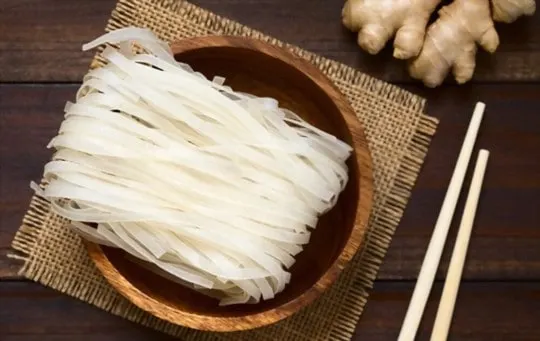
As the name implies, rice noodles are made with rice.
Rice grains are ground up to make the flour, and sometimes tapioca or corn starch is added.
Rice noodles are somewhat transparent and have a chewy texture.
You’ve probably eaten a form of rice noodles before if you’re a lover of Asian cuisine.
Dishes that use rice noodles are the world-famous Vietnamese pho and pad thai.
There are different versions of this noodle depending on the rice used.
Rice noodles are gluten-free and vegan, making them suitable for all diets.
Keep a careful watch on the noodles cook time when you prepare them, as they can become mushy.
- Key Characteristics: Rice noodles are thin and translucent noodles made from rice flour. They have a delicate texture and are widely used in Asian cuisines, particularly in Thai and Vietnamese dishes. Rice noodles are versatile and can be used in soups, stir-fries, or even in cold salads like pad Thai or pho. Use an equal amount of Rice noodles as a substitute for Ramen noodles in your recipes.
4 – Chinese Egg Noodles
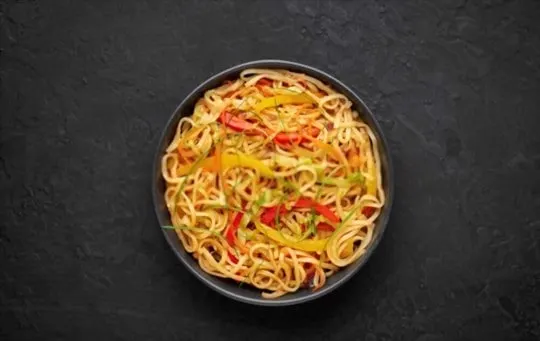
These noodles are similar to regular white noodles, but with egg included.
This makes them more nutritious than plain noodles made with white flour.
The egg adds protein and some fats, which changes the structure and taste of the noodle.
Chinese egg noodles have a springy feel, chewy texture, and a richer flavor than plain noodles.
You can make these noodles at home with ingredients you probably have already.
The egg in the dough makes it more robust, so these may be even easier to make than regular noodles.
You can also buy these at most stores, and most Asian markets will have these in stock.
Just be sure to use them all up once you open the packaging.
- Key Characteristics: Chinese egg noodles are yellow and springy noodles made with wheat flour and eggs. They have a slightly chewy texture and a rich flavor. Chinese egg noodles are commonly used in stir-fries, soups, or even in noodle dishes like chow mein or lo mein. Use an equal amount of Chinese Egg noodles as a substitute for Ramen noodles in your recipes.
5 – Green Bean Noodles

These are made from green beans, soy sauce, and a bit of flour.
This gives them a springy texture similar to other Chinese noodles.
They have a pale beige color with a neutral taste, allowing whatever you use it in to take center stage.
No matter what you make with these noodles, they can be swapped in for ramen noodles in any recipe.
Use these to make a healthy and low-carb version of ramen.
These noodles carry the added bonus of being more flavorful than ramen and containing less sodium, so you can skip on adding more seasoning if needed.
- Key Characteristics: Green bean noodles, also known as mung bean noodles or glass noodles, are light and delicate noodles made from mung bean starch. They have a slight chewiness and a neutral taste, making them a versatile option. Green bean noodles are commonly used in Asian stir-fries, soups, or spring rolls. Use an equal amount of Green Bean noodles as a substitute for Ramen noodles in your recipes.
Conclusion
Instant ramen noodles are a convenient and tasty way to get a quick bite in.
In fact, they are so delicious that they have become the no.1 currency in prisons.
However, this popular food contains more sodium than we need in our diet, so try a healthier option.
There is nothing like having a good, home-cooked meal to fill you up and boost your body’s health.
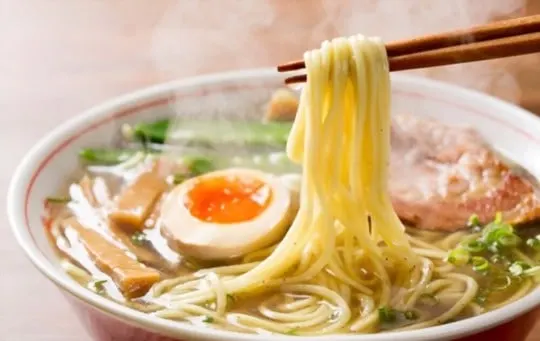
The 5 Best Substitutes for Ramen Noodles
Ingredients
- Udon
- Soba
- Rice Noodles
- Chinese Egg Noodles
- Green Bean Noodles
Instructions
- Pick your favorite substitute from the list above.
- Follow cooking directions for your selected substitute with the proper ratio of ingredients.

Andrew Gray is a seasoned food writer and blogger with a wealth of experience in the restaurant and catering industries. With a passion for all things delicious, Andrew has honed his culinary expertise through his work as a personal chef and caterer.
His love for food led him to venture into food writing, where he has contributed to various online publications, sharing his knowledge and insights on the culinary world. As the proud owner of AmericasRestaurant.com, Andrew covers a wide range of topics, including recipes, restaurant reviews, product recommendations, and culinary tips.
Through his website, he aims to inspire and educate fellow food enthusiasts, offering a comprehensive resource for all things food-related.

Leave a comment